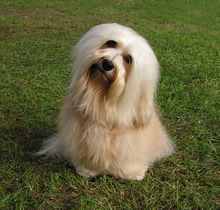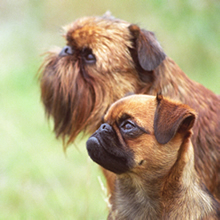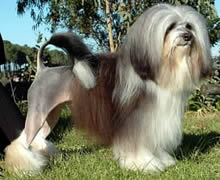Welcome to the Club
We are glad that you have found us.
At the moment the club has five breeds, Havanese, Lowchen, Griffon Belge, Griffon Bruxellois and Petit Brabancon. All these breeds belong to the toy group, they are playful, intelligent, easy to train and they like children.
Here you will find everything about the breeds. Some of these well liked toys have a long history:
Havanese
 Der Havaneser ist eine von der FCI anerkannte Hunderasse aus dem Mittelmeerraum bzw. aus Kuba. Die Rasse stammt aus der westlichen Mittelmeergegend und hat sich entlang der spanischen und italienischen Meeresküste entwickelt. Offenbar wurden diese Hunde frühzeitig durch italienische Überseekapitäne in Kuba eingeführt. Inzwischen sind alle Havaneser in Kuba ausgestorben, anscheinend konnten jedoch einzelne Hunde aus Kuba herausgeschmuggelt werden, deren Nachkommen in den USA überlebten.
Der Havaneser ist eine von der FCI anerkannte Hunderasse aus dem Mittelmeerraum bzw. aus Kuba. Die Rasse stammt aus der westlichen Mittelmeergegend und hat sich entlang der spanischen und italienischen Meeresküste entwickelt. Offenbar wurden diese Hunde frühzeitig durch italienische Überseekapitäne in Kuba eingeführt. Inzwischen sind alle Havaneser in Kuba ausgestorben, anscheinend konnten jedoch einzelne Hunde aus Kuba herausgeschmuggelt werden, deren Nachkommen in den USA überlebten.
Heute ist der Havaneser in der ganzen Welt beliebt, wohl auch deshalb weil es ihn, zum Unterschied zu den nur weiß gezüchtetenen anderen Bichons, in vielen Farben gibt.
Today the Havanese is popular in the whole world, probably because in contrast to the other white Bichons breeds, they come in many colours.
Griffons
 The Belgian Griffons are three very similar Belgian breeds that are recognized by the FCI. The three breeds differ only in colour, texture and length of coat. They may all be cross mated with each other, and in a litter of puppies all three breeds can occur.
The Belgian Griffons are three very similar Belgian breeds that are recognized by the FCI. The three breeds differ only in colour, texture and length of coat. They may all be cross mated with each other, and in a litter of puppies all three breeds can occur.
The three Belgian Griffon breeds are:
The Griffon Bruxellois (Brussels Griffon, FCI 80). Rough haired, with a beard. Red, a black mask is allowed on the head furnishing.
The Griffon Belge (Belgian Griffon, FCI 81). Rough haired, with a beard. Black, black and tan. The tan markings must be pure and of uniform, rich colour.
The Petit Brabançon (Brabant Griffon, FCI 82). Smooth-haired, They are the same colours as allowed in the other two breeds, additionally with a black mask.
The breed standard specifies that in all three breeds, a few white hairs on the chest are tolerated but not desirable. The ears are small, triangular and folded forward. Tail and ears can be cropped, but in Austria this is forbidden.
Lowchen (Petit chien lion)
 The Lowchen is a French breed recognized by the FCI.
The Lowchen is a French breed recognized by the FCI.
Today’s type of Lowchen seem to have already existed in the Middle Ages: in the Amiens Cathedral, built in the 13th Century, you can visit two little Lowchen carved in stone, which correspond exactly to the type. In the 15th Century its characteristic silhouette was often depicted in carpets. The name comes from the old clipping style: bare buttocks except for tail and feet, the front with abundant hair, so that it really looked like a small male lion. They are related to the Bichons, therefore there is a close relationship to the Maltese, Havanese, Bichon Frise, Bolognese and Coton de Tulear.
Previously, the classical fashion dog of the aristocracy, they disappeared at the end of 19th Century and in the 20th Century vanished almost completely. By 1965 there were hardly more than 40 specimens worldwide. Slowly the number of dogs rose again. In 1976 the breed was recognised by the British Kennel Club and in 1995 by the FCI with a new slightly modified standard.

